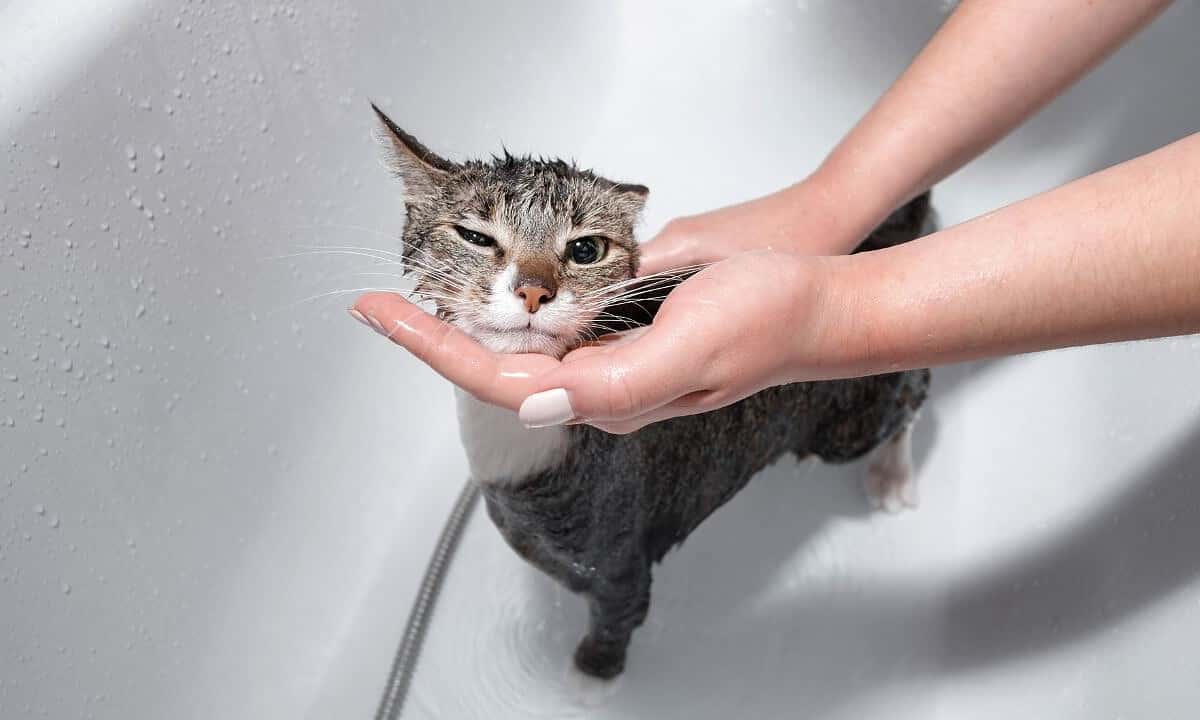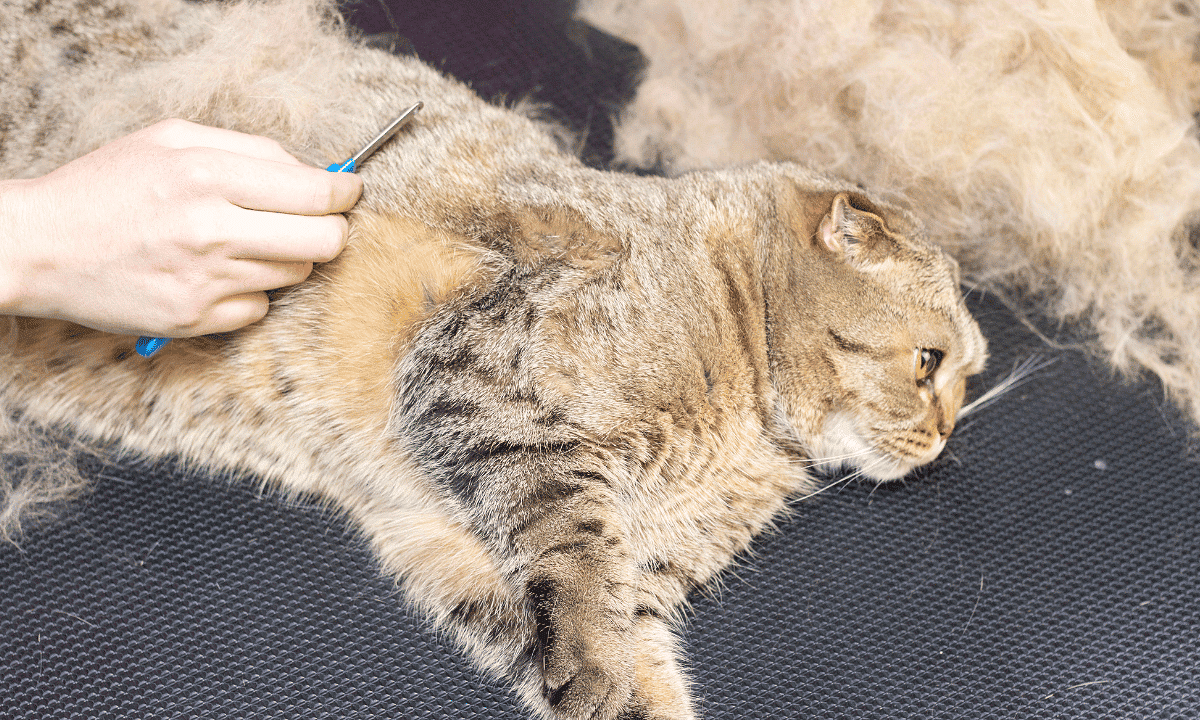Your Cart is Empty
How to Bathe a Cat Without Getting Scratched
by Dr. Holly Anne Hills BVM BVS BVMedSci May 13, 2023

The idea of bathing your cat probably sounds quite daunting and stressful to most cat owners.
With feet full of claws and the knowledge that cats hate water, you might wonder how you can possibly bathe your cat without getting scratched.
Most of the time, cats don’t actually need a bath, but there are some circumstances where it’s necessary, so here’s our guide on how to bathe a cat without getting scratched.
IN THIS ARTICLE
Do Cats Need A Bath

In general, cats do not require regular baths. Cats are exceptionally good at keeping themselves clean.
They have highly specialized tongues designed to comb through their fur and remove dirt and debris, and they spend much of their time meticulously grooming themselves.
But there are some circumstances where you might need to bathe your cat, for example, if your cat has something in their fur that could be harmful to them if they lick it off. I once had to bathe a cat that came into the clinic covered in engine oil after being rescued from under a leaking car.
In What Situation Do Cats Need To Bathe

- Some cats also need to be bathed if they have skin conditions. Allergic skin disease, fleas, and ringworm might mean your cat needs a bath to wash their fur and shape and soothe their skin. Medicated baths will be recommended by your vet where appropriate, and they will guide you on which type of shampoo product to use.
- Some cats have mobility problemsthat mean they aren't quite as able to groom themselves anymore. Elderly cats with arthritis, for example, struggle to groom certain parts of their body as they just aren't as flexible anymore. This can lead to clumping and dirty fur, as well as odors.
- Long-haired breeds may need a bath every so often to prevent matting and keep their beautiful coat in good condition. At the same time, hairless breedslike the Sphinx need more bathing. That's because they get an oily layer on their skin that can leave your home and furniture dirty.
Benefits of bathing your cat

- Reduces shedding of fur
- Reduces dander that can cause allergic reactions in people
- Reduce hairballs
- Removes fleas
- Removes dirt and debris
How Often Should You Bathe a Cat

Every 3-4 months is about right for most short and longer-haired breeds.
Some cats need more regular baths, but your vet or a professional groomer should advise you.
How to Bathe a Cat That Hates Water (Step by Step)
The reality is that most cats hate water, so that that bath time can be tricky.
Preparation is vital to ensure the process goes as smoothly as possible - minimizing stress to you and your cat and ensuring that no one gets hurt.
1. Trim nails and clean the ears before the bath

Getting these parts of the grooming process done before the bath can shorten the bathing process, meaning your cat is less likely to get stressed.
You could even trim their claws and clean their ears the day before.
2. Choose a time when your cat is relaxed

You want to bathe your cat when they are relaxed and calm, so after they've eaten or been outdoors and burnt off some energy might be a good time.
3. Use calming supplements and pheromones to create a relaxed environment

There are so many ways you can help your cat relax, but adding some calming supplements to your pet's food for a couple of weeks in the lead-up to bath time can help.
If bathtime is more spontaneous, you can use synthetic pheromones such as Feliway plug-in adaptors and room sprays to help create a relaxing environment and reduce stress.
4. Make sure your supplies are easy to reach

Getting everything you need ready before bringing your cat to the sink or tub can shorten the time your cat is being bathed.
Keep the shampoo, comb, towel, and anything else you need within easy reach. It would help if you always used a shampoo specifically designed for cats.
Never use human products; they can be too harsh on your cat's delicate skin.
5. Fill the tub first

First, fill a sink or small tub with a few inches of warm water.
This way, you can stand your cat in the shallow water to get the dirty parts wet, and then use a soft sponge or your hands and some soapy water to wash the areas that need to be cleaned.
It would help if you used a small washcloth around the face and ears to avoid getting water in the ears, eyes, nose, and mouth. Try not to soak your cat too much.
6. Make sure there are plenty of pairs of hands to help

Getting a friend or family member to help you out can help the bathing process to go more smoothly.
If your cat does try to struggle and scratch, let them go, and don't force them to be bathed, as this will create more stress.
7. Minimize running water

Cats don't like getting wet and usually freak out when they see or hear running water.
So it's best to use a few inches of water in the sink or tub and a small jug of fresh water to rinse your cat's fur after shampooing.
8. Towel dry as much as possible

Your cat will probably hate the sound and feel of a hair dryer, so towel drying as much water off their coat as possible will be relaxing for everyone.
You also have a little protection from claws when your cat is wrapped in a towel! Often, cats feel safe wrapped in a towel, which may help keep them calm.
Once dried, let your cat go and lick themselves and relax.
What Other Ways Can You Groom Your Cat

While cats don't need to be bathed very often, they still need regular grooming to keep their coats healthy and clean.
Being proactive with your cat's grooming can improve the bond between you and your feline friend.
Long-haired breeds such as Maine Coons and Ragdolls need a lot more grooming than short-haired breeds - they will need brushing daily to prevent matting and furballs.
How to groom your cat without bathing
- Brushing and combing regularly
- Cleaning the inside of your cat's ears
- Trimming your cat's claws
- Dry cat shampoos
- Cat grooming wipes
If you struggle to groom your cat at home, you can always enlist the help of a professional cat groomer.
Conclusion
Cats are meticulous groomers and do a great job of keeping themselves keen. They also hate water. So most of the time, cats don't need to be bathed.
But sometimes, a bath might be required to remove fleas or harmful substances from your cat's fur. Long-haired and hairless breeds must also be bathed to keep their skin healthy and prevent matting.
To avoid getting scratched by your cat at bath time, create a calm environment and prepare to keep the process as short as possible.
If your cat hates the bath and gets very stressed out, there are other ways to maintain your cat's coat and keep it clean without them getting wet.
Leave a comment
Comments will be approved before showing up.
Also in Cat Grooming

What Kinds Of Brushes Should I Use On My Cats? Answers By Dr. Alisa Alden
by Dawson Smith June 20, 2024
Read More
